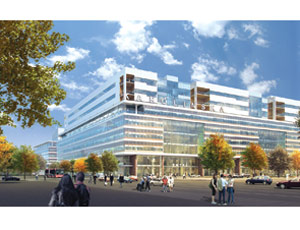Global firms are looking to strike a delicate balance in the unsteady vertical building market. Some regions are recovering from the global recession, while many parts of the world continue to struggle. Although public spending has helped prop up some markets, governments are now reining in expenditures, leaving designers and contractors fighting for limited opportunities in the private sector to help fill the void.

Johan Karlström, president and CEO of Sweden-based Skanska AB, sees some signs of recovery in the company’s main regions. On the positive side, much of the Scandinavian market has resurged, especially in the residential sector, he says. “Prices on homes are back to where they were before the economic crisis,” he says. “All of the residential builders are pushing hard to start as many projects as possible to take advantage of the market.”
Skanska broke ground in April on an $87-million apartment project in the Kungholmen district of Stockholm. In January, it is scheduled to start construction on two new apartment projects in Oslo, Norway, with a combined construction cost of $88 million.
Skanska also is finding big opportunities in other sectors around the region. The company, in a consortium with the U.K. investment fund Innisfree, was awarded in May a $2-billion contract to develop and construct the Nya Karolinska Solna Hospital, a university facility near Stockholm. In January, it will break ground on a $233-million, 66,800-sq-meter office building in Oslo for Statoil.
But the central and Eastern Europe markets have been spotty, Karlström says. In Poland, the company landed several office projects this year, including the $47-million, 14,000-sq-m Green Corner project, which is designed to achieve LEED Platinum when completed in 2012. However, Karlström says the markets in the Czech Republic as well as countries like Slovakia have been unsteady, as those countries struggle financially and cut back on projects.
Trouble in the U.K.
The U.K. has been one of the more worrisome markets for many contractors, as sweeping austerity measures by the British government have replaced massive public-sector spending. Among the biggest casualties is the Building Schools for the Future program, which was scrapped in July. Although some early projects under the program are going forward, many that were in planning have been halted.
London-based Balfour Beatty is among contractors that still have several projects moving ahead under the program. In January, it closed on a program that will deliver $715 million in major capital improvements for two school districts. However, some other projects have been cancelled. In April, Balfour Beatty was awarded a $150-million contract to rebuild or replace six schools for the Hartlepool Borough Council, but some projects have been jettisoned.
Despite the cutback, Andrew McNaughton, the firm’s chief operating officer, remains confident his company can maintain a steady stream of new work. “We see spending on education dropping back to more normal levels of activity,” he says. Balfour Beatty hopes to maintain a steady level of public work while it waits for private developers to return to the market. Although McNaughton says that a few developers are beginning to move ahead with new commercial projects already, he doesn’t expect a significant level of activity until 2012 or 2013.
Among U.K. areas that are likely to see development then is the project being built in east London for the 2012 Summer Olympics, says Joe Brown, chief innovation officer at AECOM. Developers are already planning for housing, recreational and some commercial properties, he says. “It’s basically going to be a new town in east London,” he adds.
Although many contractors see few new opportunities in the Middle East following the building bust, Brown maintains that more work is on the way. AECOM is working on the “post-crisis plan” for Dubai, to help determine what projects should be reinforced and go forward and what ones should be pushed back. “The plan looks at between now and 2020, but we’re already seeing a lot of energy and interest return to the region. It will take some time, but it will happen.”


Post a comment to this article
Report Abusive Comment